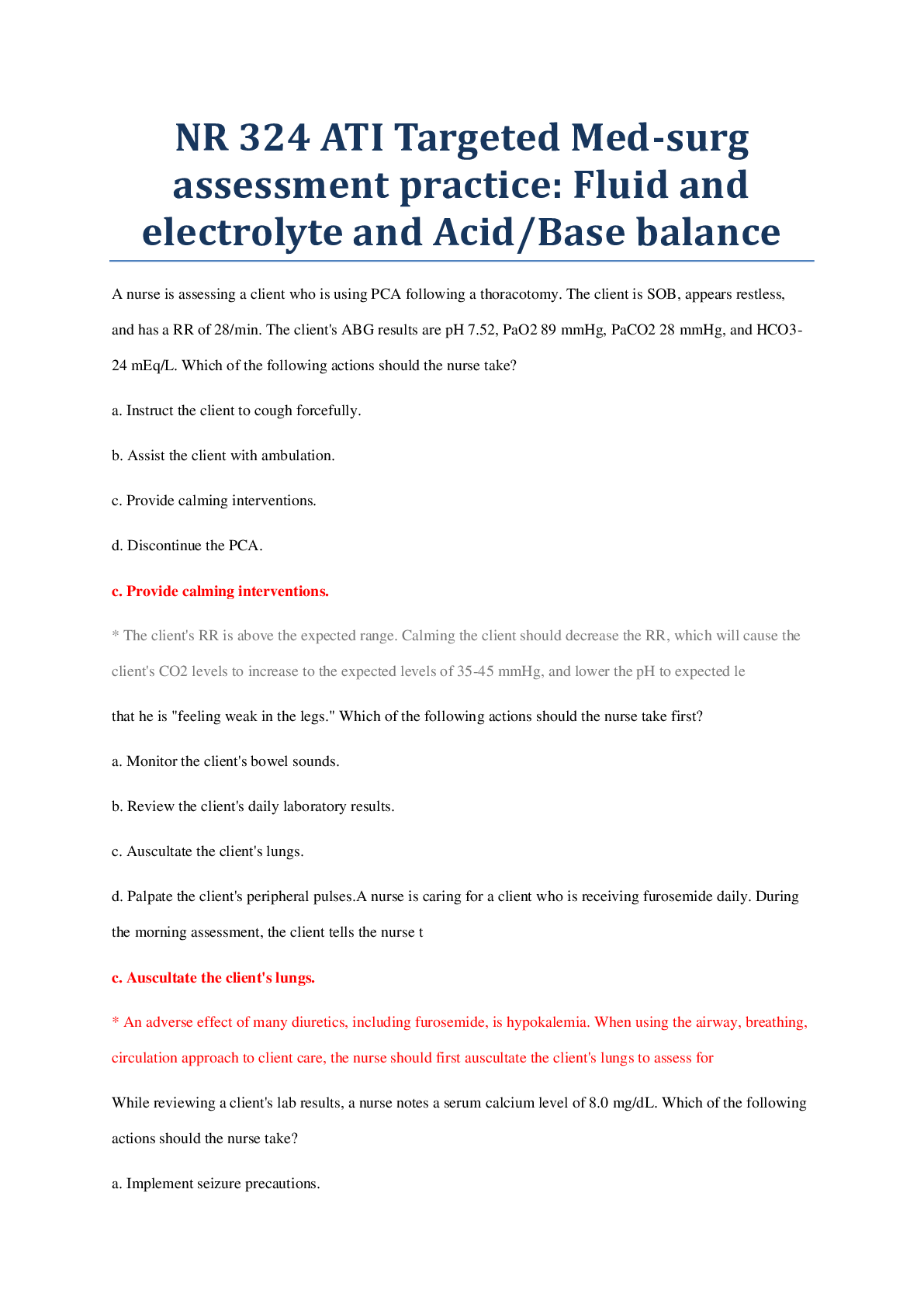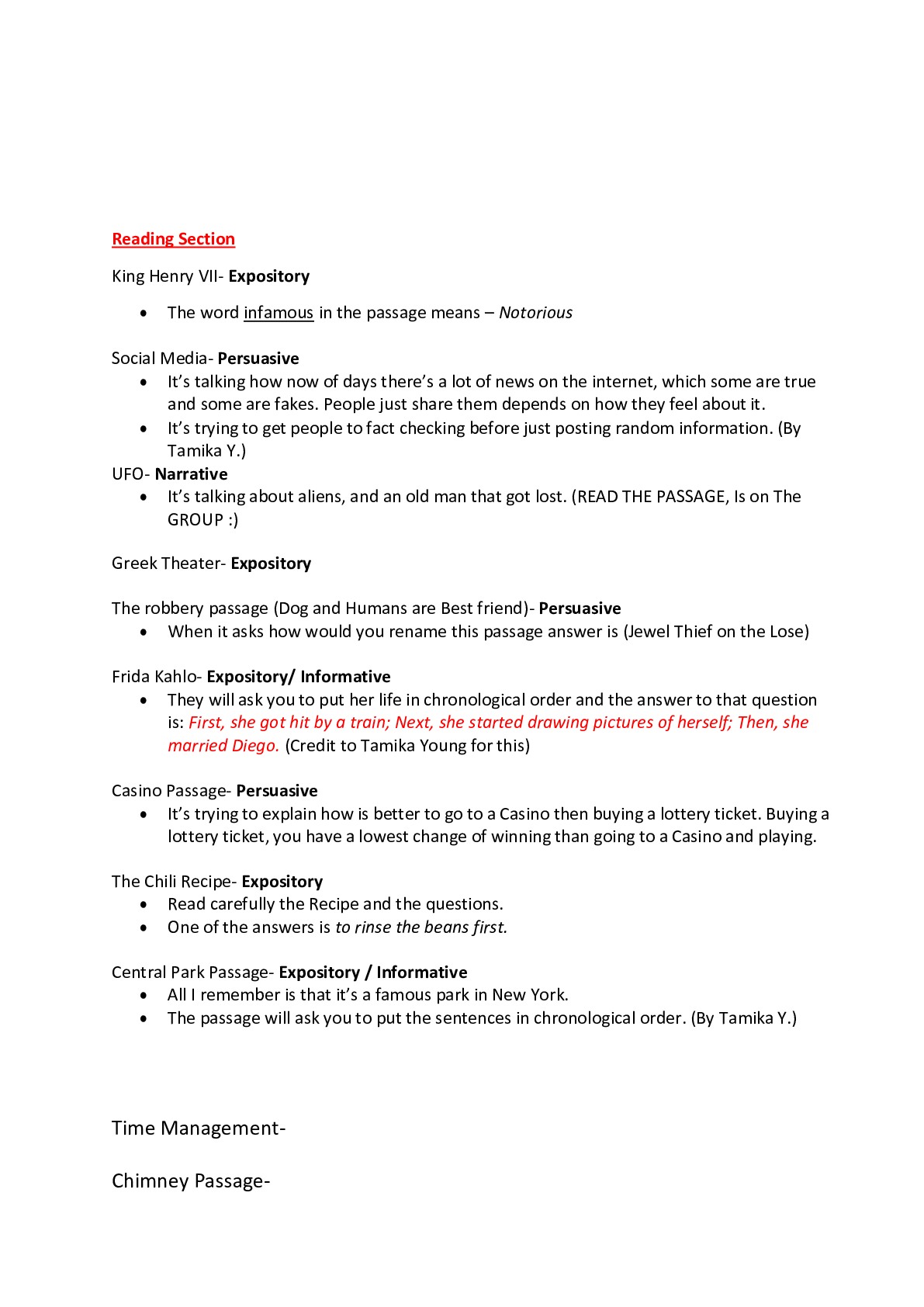ATI Maternal Newborn
Document Content and Description Below
ATI Maternal Newborn A nurse is caring for a client who is at 32 weeks of gestation and is experiencing preterm labor. Which of the following medications should the nurse plan to administer? - Betam... ethasone Rationale: The nurse should plan to administer betamethasone IM, a glucocorticoid, to stimulate fetal lung maturity and thereby prevent respiratory depression. a diet teaching for hyperemesis gravidarum "I will eat foods that taste good instead of balancing my meals." "I will avoid having a snack before I go to bed each night." "I will have a cup of hot tea with each meal." "I will eliminate products that contain dairy from my diet." - "I will eat foods that taste good instead of balancing my meals." Clients who have hyperemesis gravidarum should eat foods they like in order to avoid nausea, rather than trying to consume a well-balanced diet. hyperemesis gravidarum should avoid going to bed with an empty stomach. The nurse should instruct the client to eat a healthy snack before going to bed. should alternate liquids and solids every 2 to 3 hr to avoid an empty stomach and over filling at each meal. do not need to eliminate dairy products from their diet. The client should be encouraged to consume dairy products, because they are less likely to cause nausea than other foods. performing Leopold maneuvers steps? - The first step- palpate the client's fundus to identify the FETAL part.Second, determine the location of the fetal BACK. Third, palpate for the fetal part presenting at the INLET. Finally, the nurse should palpate the cephalic prominence to identify the attitude of the head. A nurse is reviewing the medical record of a newly admitted client who is at 32 weeks of gestation. Which of the following conditions is an indication for fetal assessment using electronic fetal monitoring? Oligohydramnios Hyperemesis gravidarum Leukorrhea Periodic tingling of the fingers - Oligohydramnios The nurse should identify that oligohydramnios requires further fetal assessment using electronic fetal monitoring. Other conditions that require further assessment include hypertension, diabetes, intrauterine growth restriction, renal disease, decreased fetal movement, previous fetal death, postterm pregnancy, systemic lupus erythematosus, and intrahepatic cholestasis. Hyperemesis gravidarum is not an indication for further fetal assessment using electronic fetal monitoring unless complications occur. Leukorrhea is a common finding during pregnancy and is not an indication for further fetal assessment using electronic fetal monitoring unless complications occur. Periodic tingling of the fingers is a common finding during pregnancy and is not an indication for further fetal assessment using electronic fetal monitoring. assessing a pregnant is at the end of the first trimester. Place the Doppler ultrasound stethoscope in which of the following locations to begin assessing for the fetal heart tones FHT? Just above the umbilicus Just above the symphysis pubisThe right lower quadrant The left lower quadrant - Just above the symphysis pubis At the end of the first trimester of pregnancy, the client's uterus is approximately the size of a grapefruit and is positioned low in the pelvis slightly above the symphysis pubis. Therefore, the nurse should begin assessing for FHT just above the symphysis pubis. Therefore, the nurse might not hear FHT in the right or left lower quadrant. The nurse should assess FHT using the Doppler stethoscope just above the umbilicus if the fetus is in a transverse or breech presentation and the client is at a minimum of 22 weeks of gestation. A nurse is caring for a client who is at 35 weeks of gestation and is experiencing placenta previa. Which should take? Perform a vaginal exam to determine cervical dilation every 2 hr. Instruct the client to ambulate in the hallway once every 4 hr. Administer betamethasone to the client via IM injection. Initiate continuous external fetal monitoring. - Initiate continuous external fetal monitoring. The nurse should identify that a client who has a placenta previa and is actively bleeding is at an increased risk for preterm labor and hemorrhage. The nurse should initiate interventions such as bed rest, pelvic rest, and continuous fetal heart monitoring, which assesses fetal well-being and the presence of contractions. The nurse should obtain IV access and monitor laboratory values. Also, the nurse should implement interventions to prepare for an emergency birth. Betamethasone is given to enhance fetal lung maturity for clients who are experiencing preterm labor. It is given to clients between 24 and 34 weeks of gestation. A client who has a placenta previa and is actively bleeding is at an increased risk for preterm labor and hemorrhage. Ambulating frequently could potentially stimulate labor and increase vaginal bleeding. Therefore, the nurse should place the client on bed rest with bathroom privileges. [Show More]
Last updated: 2 years ago
Preview 1 out of 35 pages
.png)
Buy this document to get the full access instantly
Instant Download Access after purchase
Buy NowInstant download
We Accept:

Reviews( 0 )
$11.00
Can't find what you want? Try our AI powered Search
Document information
Connected school, study & course
About the document
Uploaded On
Jul 22, 2022
Number of pages
35
Written in
Additional information
This document has been written for:
Uploaded
Jul 22, 2022
Downloads
0
Views
190
.png)

.png)
.png)
.png)
.png)
.png)
.png)

.png)
.png)
.png)
.png)
.png)













